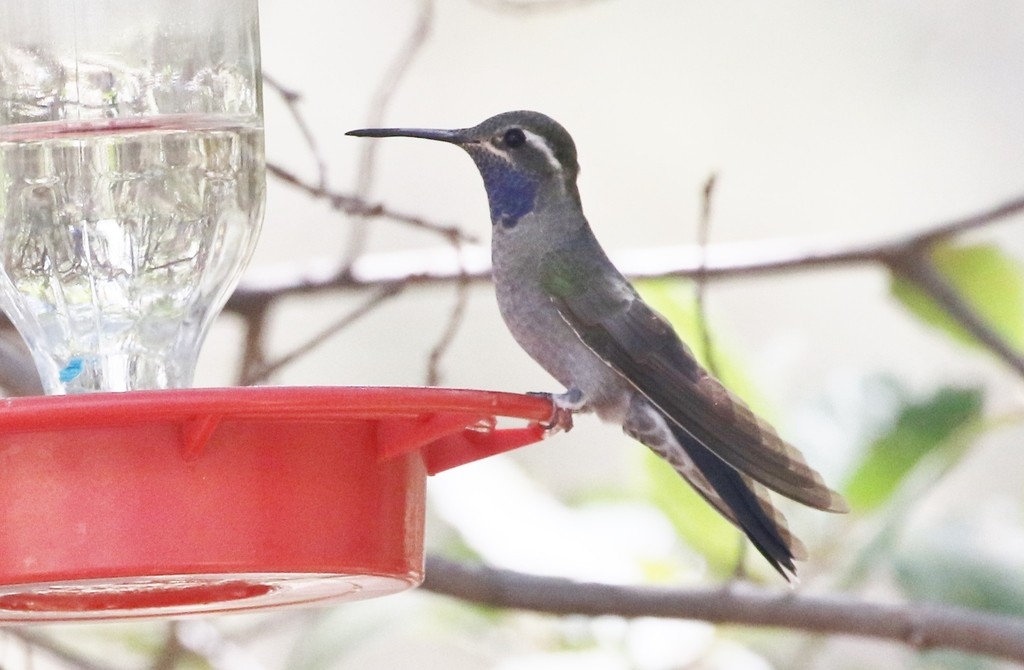Blue-throated Mountain-gem
A species of Mountaingems Scientific name : Lampornis clemenciae Genus : Mountaingems
Blue-throated Mountain-gem, A species of Mountaingems
Botanical name: Lampornis clemenciae
Genus: Mountaingems
Content
Description General Info
 Photo By silversea_starsong , used under CC-BY-NC-4.0 /Cropped and compressed from original
Photo By silversea_starsong , used under CC-BY-NC-4.0 /Cropped and compressed from original Description
The Blue-throated mountaingem is a fairly large hummingbird, reaching 11.5 to 12.5 cm (4.5 to 4.9 in) in length and 6 to 10 grams in weight. The Blue-throated Hummingbird is dull green on the top of its body, fading to medium gray on its belly. It has a conspicuous white stripe behind its eye and a narrower stripe extending backward from the corner of its bill, bordering a blackish cheek patch. Its tail feathers are iridescent blue-black with broad white tips on the outer two to three pairs. The species gets its name from the adult male's iridescent blue throat patch (gorget), but the female lacks this, having a plain gray throat. 
Size
13-14 cm (5-5.5 in)
Life Expectancy
7-12 year
Nest Placement
Tree
Clutch Size
1 - 2 eggs
Incubation Period
1 - 3 broods
Number of Broods
17 - 19 days
Nestling Period
24 - 26 days
Feeding Habits
Blue-throated Mountain-gem have a varied diet, feeding on nectar from flowers and feeders, as well as a range of invertebrates including flying insects, aphids, flies, bugs, beetles, wasps, spiders, and harvestmen. Their foraging tactics are diverse, capturing prey in flight, gleaning from foliage, and hunting from perches or over water. They forage intensely in the morning and late afternoon, adapting their diet to the availability of floral resources, especially during the dry season.
Habitat
The blue-throated Mountain-gem thrives in cool mountainous regions, predominantly within coniferous and mixed woodlands at elevations of 3,200 to 12,800 feet. Their preferred habitat features understories and flower-abundant areas near wooded streams in canyons, where a mix of sycamore, pine, oak, juniper, and fir trees flourish. Seasonally, they may also adapt to moist lowland areas like streambeds and gardens.
Nest Behavior
Blue-throated Mountain-gem females solely build the nest, occasionally placing new ones atop older structures. Egg-laying and nest construction timing are not specified, but females may recycle old nest materials. Parental care specifics are not detailed, but like other hummingbirds, the female likely assumes most responsibilities.
Nest Characteristics
Nests of blue-throated Mountain-gem are positioned at least 6 feet high on various supports such as branches, ledges, and artificial structures. They measure about 2 inches wide and 3-10 inches high, with an internal cup of 1-2 inches wide and 0.6-1.3 inches deep. Constructed with spider silk, plant fibers, animal hair, feathers, and other natural materials, these nests lack the lichen decoration typical of other hummingbirds.
Dite type
Nectivorous
General Info
Feeding Habits
Bird food type
Bird Feeder Type

Nectar Feeder
Behavior
Blue-throated Mountain-gem exhibits engaging daily behaviors, particularly in mating rituals, where males forgo flashy flights for singing and displaying their vibrant blue throat and white-tailed corners to attract females—a process that spans several days. Territory defense is marked by the 'whisper song,' more subdued than their typical chip notes, aiding in territorial marking and repelling rival males, who they may confront using intimidating postures enhanced by their expansive plumage and tail movements. Uniquely, females reciprocate male songs in a rare duet among hummingbirds. Post-mating, blue-throated Mountain-gem's females solely undertake nesting and chick-rearing. Additionally, blue-throated Mountain-gem exhibits territorial aggression, especially during breeding, with territory sizes recorded up to 0.2 acres in Mexico. New fledglings also show early territorial behavior, indicating a strong instinctive drive for space and resource dominance.
Species Status
Not globally threatened.
Scientific Classification
Phylum
Chordates Class
Birds Order
Swifts and hummingbirds Family
Hummingbirds Genus
Mountaingems Species
Blue-throated Mountain-gem